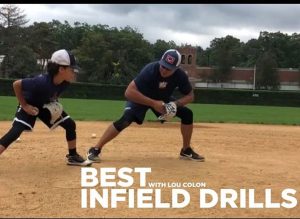Transitioning from an infield position to 1st base in baseball can be a rewarding move, but it comes with its own set of challenges and responsibilities. 1st base is a unique position that demands different skills and techniques. In this guide, we’ll offer guidance for infielders making the move to 1st base, helping you adapt to the position’s distinct responsibilities and excel on the field.
1. Embrace the New Role
The first step in transitioning to 1st base is embracing your new role. Understand that as a 1st baseman, your primary responsibility is to secure outs at 1st base, whether it’s catching throws from other infielders or making putouts on ground balls. Recognize that your primary objective is not to cover ground or make flashy plays but to be a reliable defensive presence on the bag.
2. Develop Soft Hands
One of the most critical skills for a 1st baseman is having soft hands to handle throws from other infielders. Work on your ability to receive throws cleanly and smoothly, minimizing errors and ensuring you’re always prepared to make the catch.
- Catch with Fingers: Use your fingers and not your palm to catch the ball. This allows for greater control and minimizes the risk of mishandling throws.
- Practice High and Low Throws: Work on catching throws that are high, low, and off-target. This will help you become more versatile in handling various types of throws.
3. Footwork Matters
While you won’t be ranging across the infield like other infielders, proper footwork remains essential at 1st base:
- Positioning: Be in the right position to cover the base. Your right foot (left foot for left-handed first basemen) should be on or near the bag. This provides you with a stable base to stretch for throws.
- Stretching for Throws: Develop the ability to stretch for throws to make outs. Practice your stretching exercises to maximize your reach while keeping one foot on the base.
4. Communicate Effectively
Clear communication with your fellow infielders is essential to avoid confusion and ensure plays are executed smoothly. Talk to your pitcher, shortstop, and second baseman to coordinate plays and coverages.
- Call for the Ball: If you’re in the best position to field a ball, call for it loudly and clearly to avoid collisions.
- Coordinate on Double Plays: Work with the middle infielders on double-play situations. Understand your role in initiating or completing double plays.
5. Anticipate Plays

As a 1st baseman, you need to anticipate plays before they happen:
- Reading the Batter: Pay attention to the batter’s swing and contact to anticipate where the ball might be hit.
- Know the Game Situation: Understand the game situation, including the number of outs, the score, and the baserunners. This information will help you make quick decisions.
6. Master the Pick-Off Move
Develop a reliable pick-off move to keep opposing runners in check:
- Quick Toss: Practice making quick and accurate throws to pick off runners who stray too far from the base.
- Timing: Work on your timing to catch runners by surprise.
7. Repetition and Practice
Transitioning to 1st base requires practice and repetition. Work with your coaches and teammates to simulate game situations and practice receiving throws and making plays at the base.
Conclusion
Transitioning from the infield to 1st base in baseball can be a smooth process with the right mindset and dedication to developing the necessary skills. Embrace your role as a dependable defensive presence, work on your receiving skills, communicate effectively, and anticipate plays. With practice and commitment, you can excel in your new position and contribute significantly to your team’s success on the field.
